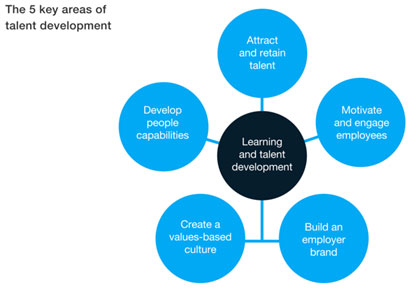Learning Strategy & Development
The learning function of an organization has a strategic role in five separate areas

Source: Adapted from Nick van Dam, 25 Best Practices in Learning & Talent Development, second edition, Raleigh, NC: Lulu Press, 2008
- Attract and retain talent. Traditionally, learning focused solely on improving productivity. Today, learning also contributes to employability. Workers are now in charge of their personal and professional growth and development—one reason that people list “opportunities for learning and development” among the top criteria for joining an organization. Conversely, a lack of L&D is one of the key reasons people cite for leaving a company.
- Develop people capabilities. Human capital requires ongoing investments in L&D to retain its value. When knowledge becomes outdated or forgotten—a more rapid occurrence today—the value of human capital declines and needs to be supplemented by new learning and relevant work experiences.
- Create a values-based culture. As the workforce in many companies becomes increasingly virtual and globally dispersed, L&D can help to build a values-based culture and a sense of community. In particular, millennials are particularly interested in working for values-based, sustainable enterprises that contribute to the welfare of society.
- Build an employer brand. An organization’s brand is one of its most important assets and conveys a great deal about the company’s success in the market, financial strengths, position in the industry, and products and services. Investments in L&D can help to enhance company’s brand and boost its reputation as an “employer of choice.”
- Motivate and engage employees. The most important way to engage employees is to provide them with opportunities to learn and develop new competencies.
These five functions are critical to the success of an L&D organization, but the critical step is aligning the L&D strategy with the overall business strategy. It isn’t enough to develop programs which will improve one or all of those five functions, but in order to prove ROI and get executive buy in for your programs, you need to create a learning strategy that answers these questions:
- Are your learning strategies aligned to the business strategies?
- Are you measuring the impact of your programs on overall business strategies and goals?
- Does HR have a seat at the table and a strong partnership with the business units?
- Does the company have a list of capabilities or competencies for which they can measure behavior, and is the L&D function creating programs to promote those capabilities and competencies?
- Is L&D connected to HR interventions, performance conversations and appraisals in order to help grow and improve employees?
- Is the correct technology in place to aid in the learning, and do your employees know how to use it?
We have worked with million and billion dollar organizations helping them to answer these questions and to build learning strategies that move the needle regarding business strategies. Let us ask the hard questions and make recommendations to help you deploy learning in the most effective way possible.